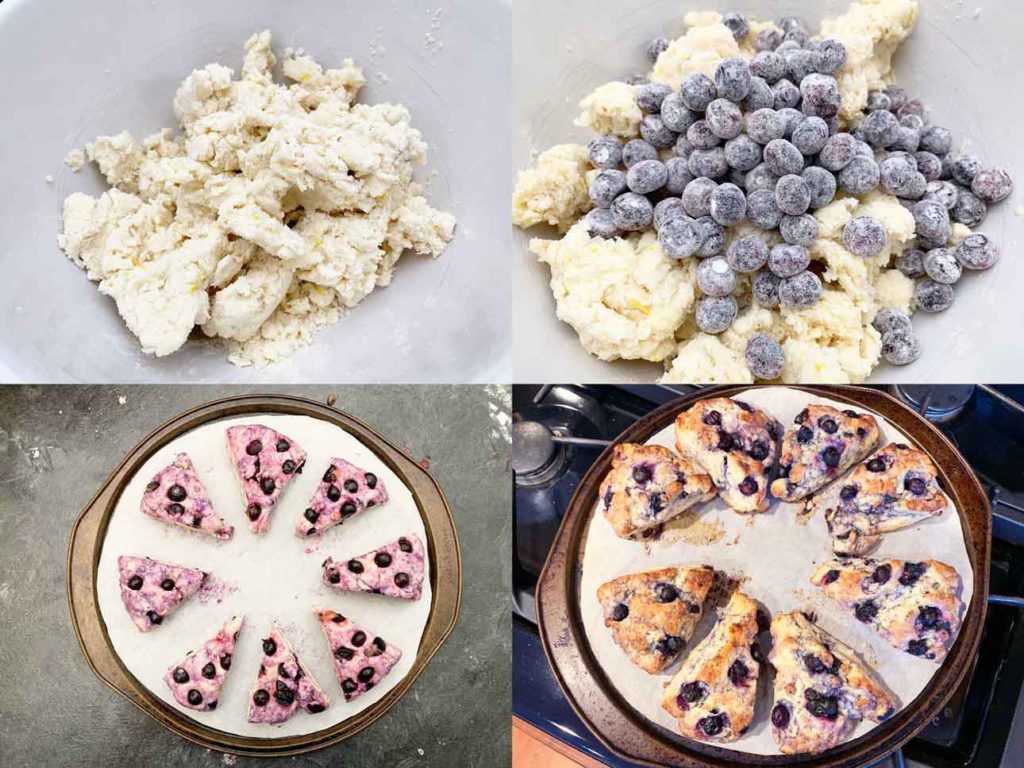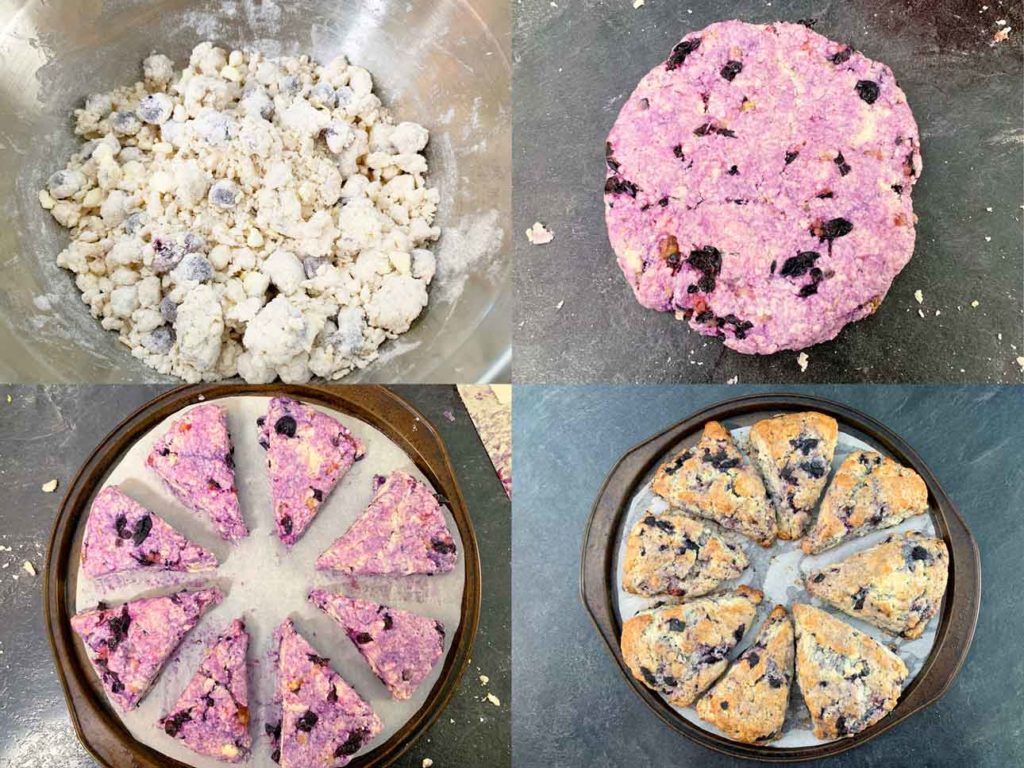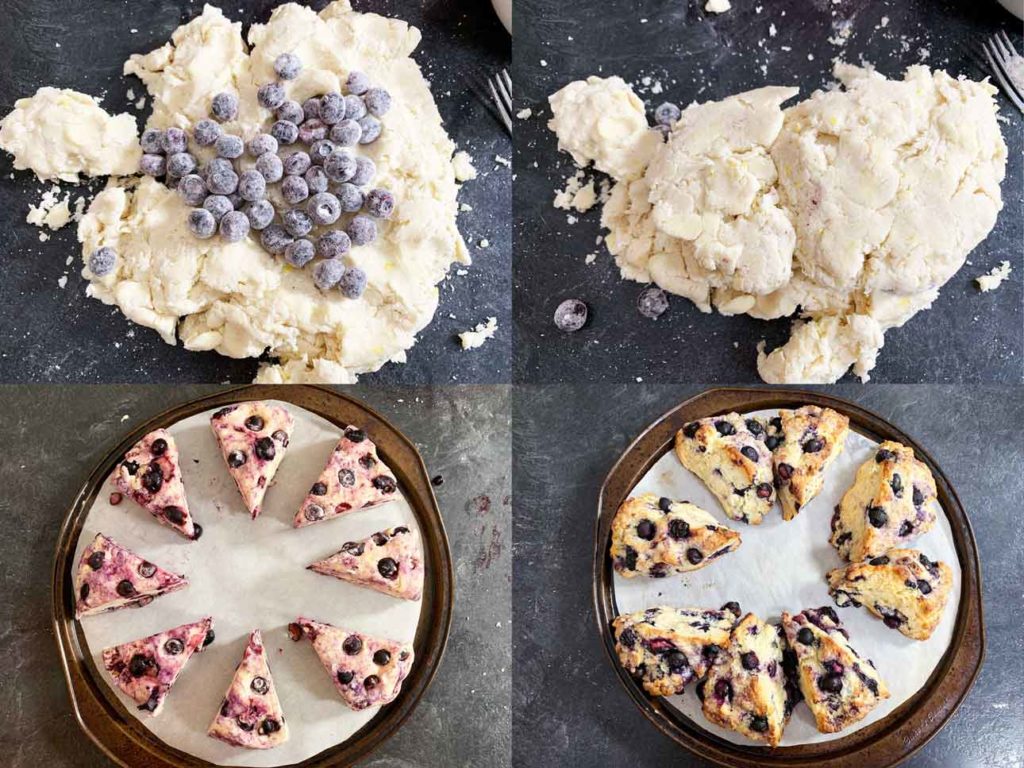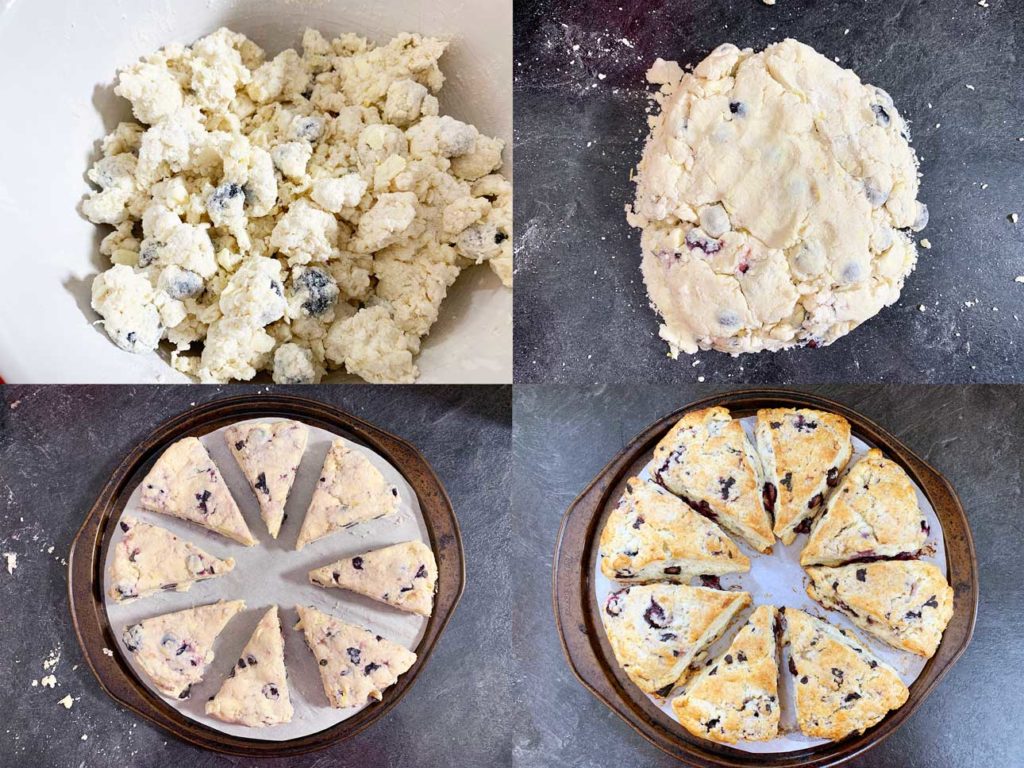If you start scouring the internet for blueberry scone recipes, you’ll notice that most, if not all, call for fresh blueberries. However, these same recipes casually mention that frozen blueberries will also work just fine. The problem with frozen blueberries though, is that they are very delicate, and tend to explode as they thaw if not handled very carefully.
A couple of weeks ago, I had a major hankering for some blueberry lemon scones. The fresh blueberries at the store didn’t look particularly appetizing, so I checked the frozen section instead. I found a big bag on sale, so I picked it up and decided to do some testing to see just how easily fresh blueberries could be swapped for frozen.
One of the big complaints with using frozen blueberries in baking is that they have a tendency to turn your batter bright purple. I tried three different mixing techniques to see if I could find a method that worked well specifically for frozen berries.
I looked at a number of recipes to see if there were any different methods or recommendations. The process was roughly the same across all of them. Start by whisking together your dry ingredients. Next, cut your butter into your flour mixture until it resembles course crumbs. Some recipes recommended stirring in your liquid, and then adding the blueberries. Others recommended adding the blueberries, and then stirring in the liquid. I decided to try both methods to see what worked best.
Batch 1: Liquid, then blueberries

For this batch of scones, I added the liquid to the dry ingredients first, and then attempted to stir in the blueberries. I’ve heard that you should dust your blueberries with flour before adding them to your scones. I tried it with this batch, but to be honest, I really don’t think it did anything other than add an extra step to my process.
The end result? A big, sticky mess. The dough was too thick to stir the blueberries in. I tried to knead the blueberries into the dough, which caused them to erupt and turn my dough very purple. Worse than that, they didn’t seem to want to incorporate into the dough, and kept popping out and rolling all over my counter top. I ended up roughly shaping the dough into a disc, and then poking holes all over the top with my finger. I then dropped a blueberry into each hole and called it a day.
The blueberries released quite a bit of extra liquid when they burst, which I was a little worried about. However, they still seemed to turn out well. Despite not being the prettiest scones, they had a nice texture. Although the distribution of blueberries wasn’t the best.
Batch 2: Blueberries, then liquid

After realizing I couldn’t just casually fold the blueberries in to such a thick dough, I decided to try the other method of stirring the blueberries in with the dry ingredients, and then adding the liquid.
This went really well at first. I mixed up the dough with ease and the blueberries didn’t bleed everywhere. Shaping the dough was tricky though. As I pressed the dough into a disc shape, many of the blueberries burst, resulting in more purple dough.
Overall, this mixing method worked much better. The dough still ended up somewhat purple, but the distribution of blueberries was much better, and the scones baked up very nice and even.
Batch 3: Liquid, then blueberries – round 2!

For my final attempt, I decided to try the first method again (liquid first, followed by blueberries), but with a different technique for incorporating the berries into the dough.
This time, I mixed the dough together, then pressed it out flat on the counter. I sprinkled a few blueberries on top, and folded the dough in half, enclosing the blueberries within the dough.
I pressed the dough out thin again, sprinkled on some more blueberries on top, and folded the dough over another time. I did this three or four times in total, and then shaped the dough into a disc.
Like with the first batch, the blueberries didn’t seem to want to incorporate into the dough. They kept trying to pop out and roll around. Again, I had to poke holes into the top with my finger, and stick the rogue blueberries back in place.
This technique resulted in the “cleanest” looking, non-purple dough, but the distribution of blueberries was not very good, and the scones baked up unevenly.
The Fresh Comparison

After making the three batches with frozen berries, I decided to pick the technique that seemed to work the best (attempt #2) and try it with fresh blueberries to see if it was easier. Short answer? Yea, it was way easier.
Adding the blueberries to the dry mixture first, and then adding the liquid, helped incorporate the berries nicely throughout the dough. I still had a few of them burst while I was pressing and shaping the disc, but not nearly as many as the frozen berries. The dough ended up being a lot less purple and the scones baked up nice and even.
Additional Things to Note
After trying these scones out several times, here are a few other tips and tricks that are worth noting:
- Keep Your Ingredients Cold: Cold butter. Cold cream. Cold berries. Cold everything. You want the butter to only start melting when it gets into the oven and not before. This is what makes scones tender and flaky.
- Work Fast: This ties in with keeping everything cold. The longer you mess about, the more time your dough has to warm up. Work quickly and don’t dawdle. Make sure you have your oven pre-heated and your baking sheet ready before you start mixing everything up.
- Don’t Overmix: Avoid mixing the dough more than you absolutely have to. The more you mix, the tougher your scones become. As soon as your dough is holding together, stop mixing and shaping.
- Stop Worrying: If you’re using frozen berries, your dough is going to turn purple. It’s just a fact of life. Should you worry about it? No, not at all. In fact, celebrate it! Who wouldn’t want to eat a beautiful purple scone? If you do find someone, tell them to bugger off, and stop being friends with them immediately. Your scones will still be delicious, regardless of their opinion.
Blueberry Lemon Scones
Ingredients
- 2 cups all-purpose flour
- 1/3 cup sugar
- 1 tbsp baking powder
- 1 tbsp lemon zest
- 1/2 cup very cold butter
- 1 cup blueberries (fresh or frozen)
- 1 tsp vanilla
- 1 cup whipping cream
Lemon Glaze
- 1/2 cup icing sugar
- 1-2 tbsp lemon juice
Instructions
- Pre-heat your oven to 400°F, and line a baking sheet with parchment paper.
- In a large bowl, whisk together flour, sugar, baking powder and lemon zest.
- Use a pastry blender to cut the butter into the flour until the mixture resembles course crumbs.
- Stir in the blueberries.
- Pour in the cream and vanilla. Use a fork to stir the mixture, taking care not to crush the blueberries. It should start to form a dough. Keep stirring until you've incorporated as much of the flour as you can (you'll still have some crumbly flour bits).
- Turn the mixture out onto a clean, flat surface. It will be quite crumbly to start. Gather all the crumbs and dough together and gentle press it into a rough disc shape, about an inch thick.
- Slide a pastry scraper under the dough and use it to fold the dough in half. Press the mixture down into a disc shape again. Repeat the folding process a few times until the crumbs have been incorporated and the dough holds together. Try not to overwork the dough too much.
- Once your dough is holding together in a nice disc shape, cut it into 8 triangles and place on your parchment lined baking sheet 2-3 inches apart. Bake for 20-25 minutes until the tops are golden brown.
Make the Glaze
- Add lemon juice to icing sugar and stir until well combined. Start with 1 tbsp of lemon juice, and add a little more as needed. Your glaze should be just runny enough that you can drizzle it with a spoon onto your scones.


